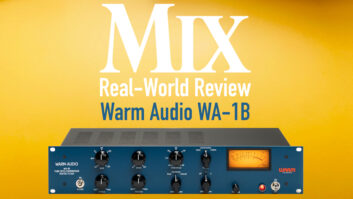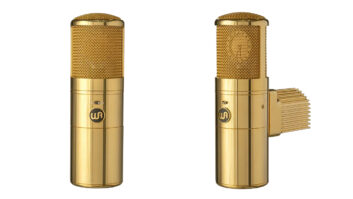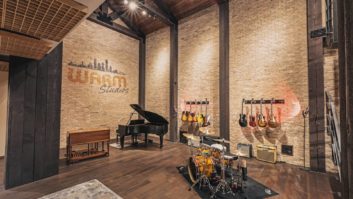
Getting a signature sound isn’t achieved by simply running audio through an old Neve or API console; it comes from variations of cranking up the input gain, bringing down the fader and creating big beautiful tones through harmonic distortion. These days, in the new world of recording, I find that it’s not as easy to play with gain structure, if I even can at all. Warm Audio, with its solidly built TB12, aims to give back this option.
Warm Audio has received quite a bit of buzz from its first preamp offering, the WA12, a feature-packed and beautiful-sounding half-rack unit that was released a few years ago. Since then the busy company run by Bryce Young and based in Austin, Texas, has released the WA12 500 Series version and now its latest offering, The ToneBeast.
Plentiful Choices
The uniqueness of the TB12 is found in its selectable dual set of op amps, two sets of capacitor chains, and two sets of CineMag output transformers. The layout is very straightforward, even though it gives you many options.
The connections are exactly what I want to see on such a unit: an XLR input on the front and back of the unit, a line level input on the back of the unit and a Hi-Z instrument input on the front. This Hi-Z input allows you to send any connected instrument, acoustic guitar, bass, and keyboards through the entire signal path, including the Discrete 312 preamp design with the coupled CineMag transformers, the op amps and the CineMag output transformers. Balanced XLR and ¼-inch outputs are provided on the back of the unit, along with a send and return effects loop for inserting your favorite compressor or EQ. The back also has a connection for an external line-lump 24-volt AC power transformer, keeping the transformer away while the power supply is built-in.
The front of the TB12 is filled with options, yet there is plenty of room to work. The input control section comprises switches for Hi-Z and line input selection, +48V phantom power, -20dB pad, phase reverse, and an 80Hz HP filter, each with its own LED. There is also a Tone button that switches the input impedance from 600 to 150 ohms. This not only affects the tone but also adds a volume boost of about 6 dB.
The Tone section is where this unit sets itself apart from everything else in my rack. The op amp selector switched seamlessly between the built-in classic Melcor 1731 style op amp dubbed the x731, and the Deane Jensen-modeled classic 918 op amp, called the x18. Each sounds and distorts differently from the other. Next in the signal path is the capacitor. The vintage selection sends your audio through the tantalum caps, while the clean setting routes through the electrolytic caps. The difference is very subtle. Next is the output transformer. The TB12 has two CineMag output transformers: a custom Steel transformer designed just for the TB12 and a 50-percent Nickel core transformer. For an audio purist approach, you can also bypass the output transformers altogether. This will drop the output signal by 8 dB and change the output from balanced to unbalanced.
In the Gain and Saturation section, the input gain yields 65dB of gain, but can jump up to 71dB of gain with the Tone button pressed, which is more than enough for ribbon mics and even my 1940s Turner mic with its paper diaphragm—which, by the way, sounds better through the TB12 than it ever has. Last is the important Output Volume control. Between the input Gain control and this Output control, you can easily drive this unit well into distortion, from beautiful and clean, to a nice, warm and fuzzy harmonic distortion, to complete overdrive. There are other units that have an output level control on them, but none that I know of that are built into a preamp whose focus is to be driven hard.
Into the Studio
The key to this unit is to use the Gain to drive the op amps, capacitors and output transformers so you are just hitting the point where harmonic distortion is flavoring the sound. The TB12 has a simple five-segment LED level meter that does a decent job of showing when the headroom threshold is being approached. Below the threshold, the TB12 sounds clean and tight, and very appealing. But the real characteristics of the different op amps and transformers come alive once they run out of headroom.
I first tried miking a guitar cabinet. I played the same eight-bar rock chord progression each time, and tried all the combinations. The test was done with a Gibson Les Paul Signature T, into a 1986 Seymour Duncan convertible handmade amp, feeding a 1976 Marshall 412 with its original 25-watt greenback speakers. I used an Audix D1 mic into the TB12, feeding straight into the Apogee A/D into Sequoia. All electronics involved were warmed up over an hour.
The difference between the transformers is much more apparent than the op amps or caps. I could instantly hear and feel the differences in the tone while I was tracking. The Nickel felt as if the low-midrange became more predominant and high-midrange ducked down slightly, yet the presence was still there. The Steel is much more up front with a better definition to its character. It also distorted more easily. Upon listening back and comparing, both transformers have their own sound, and when pushed, they reacted differently to the audio and imparted a slightly different flavor of distortion and slightly different EQ curve, while both added a vintage quality. Both the 1731-style op amp and the 918 op amp gave tight, punchy results.
The next day I started producing the new Chris Kelly album, a modern version of The Cars with all live instruments and lots of opportunities for using the TB12. First up were drums. I ran the large-diaphragm condenser on the floor tom of the four-piece kit through the TB12. Even with the -18dB pad on the mic, I still needed the -20dB pad on the preamp to control the level. The lowest the input Gain control will go is +29 dB, so there is a lot of gain available. The sound was tight and punchy and worked out perfectly. I see the need already to have eight channels of TB12 available to do an entire kit.
I tracked bass directly through the unit and chose the Nickel transformer setting. This gave me the tonal curve I wanted, and pushing the Gain gave me the warm-fuzziness. We also tracked electric guitars through the TB12 and selected different signal paths to accompany the different guitar amps. It’s really like having multiple preamps at your disposal.
Vocals sounded amazing through the unit. I first used an ADK A51TC into the TB12 on Chris’ vocals. Using the x18 op amp, the Vintage caps, and the Steel output transformer, I was able to get that wonderful throaty, full, tight male vocal sound we were looking for. The ability to add some hair to the vocal sound with the TB12 made it perfect for the artist’s voice and most all the elements on the record.
Impressive?
I am very impressed with the level of sophistication in the design of the TB12. For instance, switching between the op amps and transformers did not produce any adverse pops or change in volume. In fact, only switching from Nickel to Steel gave the ever so faint click. Warm Audio is trying to offer the TB12 at a price that hasn’t been approached by such a high-quality and versatile preamp. This is not a prosumer product; this sits alongside all the API, Manley, Neve, RND preamps that cost two to four-times as much with fewer options. This unit is staying in my rack.
Tim Dolbear is a producer and mixing/mastering engineer at Eclectica Studios in Austin, Texas.
TRY THIS
A huge benefit of switching between op amps in the TB12 is the different tones and harmonic distortion you can generate. If you are a gearhead, note that both op amps are 2520 6-pin design so you can easily pop in your own.
Product Summary
COMPANY: Warm Audio
PRODUCT: TB12 ToneBeast Microphone Preamplifier
WEBSITE:www.warmaudio.com
PRICE: $599
PROS: Good sound, highly versatile, full-featured, fully discrete circuit, 71 dB of gain, three U.S.-made CineMag transformers.
CONS: Not as drastic a difference as one might hope for between some tone settings.







